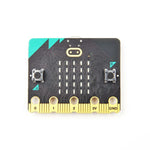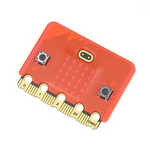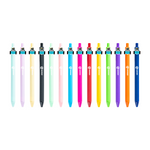How ELECFREAKS Help Schools Enhance STEAM Education Through micro:bit?
Amidst the global wave of digitalization, traditional educational models are facing unprecedented challenges. For a long time, traditional education has often been confined to the inculcation of knowledge in single disciplines, with content updates lagging behind the needs of industrial development. Students passively receive knowledge, lacking the cultivation of practical abilities and innovative thinking. However, the economic structure and industrial development of the 21st century have put forward brand-new requirements for talents - enterprises are in urgent need of comprehensive talents with collaborative capabilities, creativity, critical thinking, and effective communication skills. Such talents must not only master solid professional knowledge but also possess the ability to integrate and apply interdisciplinary skills. Against this backdrop, STEAM education has emerged, and ELECFREAKS, with the support of micro:bit, has become an effective aid for schools to promote STEAM education.
I. What is STEAM Education? Why is it Crucial for Modern Education?
When it comes to STEAM education, many people simply understand it as the combination of five disciplines: Science, Technology, Engineering, Arts, and Mathematics. In fact, it is an educational concept and practical model of interdisciplinary integration. Different from the traditional subject-based education, STEAM education breaks down the barriers between disciplines, organically combines knowledge and skills from different fields, guides students to start from real-life scenarios, and solves practical problems through inquiry-based learning, thereby achieving the all-round improvement of abilities and thinking.
The core value of STEAM education is reflected in the following three aspects:
1. Stimulating Interest and Cultivating the Awareness of Lifelong Learning:
With "interest-driven" as the core, STEAM education enables students to experience the charm of art and science from an early age through interesting practical projects (such as making intelligent toys and designing environmental protection devices). It helps students understand the connection between knowledge and life, thereby stimulating their internal enthusiasm for learning and developing the habit of lifelong curiosity and continuous exploration.
2. Developing Comprehensive Abilities to Meet the Needs of Future Talents:
In the process of STEAM learning, students need to complete projects through team collaboration (collaborative ability), independently design solutions (creativity), analyze problems and optimize solutions (critical thinking), and clearly express ideas and achievements (communication skills). These abilities are the core competitiveness in the future workplace.
3. Cultivating a "Growth Mindset" and Enhancing the Ability to Resist Setbacks:
STEAM projects often do not have a "single correct answer". Students will encounter failures constantly in practice (such as code errors and device malfunctions). Educators will guide students to regard failures as "opportunities for optimization" and finally achieve their goals through repeated trial and error and program adjustment. This growth mindset of "not fearing failure and continuous improvement" is crucial for students' future development.
In short, STEAM education is not only the transfer of knowledge but also the cultivation of "people". It aims to enable students to learn to use interdisciplinary knowledge to solve problems, understand information, evaluate evidence, and make decisions in a complex and changing world, and become "complete people" who can adapt to future society.
II. micro:bit: The "Portable Laboratory" for STEAM Education
Although the concept of STEAM education is advanced, many schools face the problem of "difficulty in implementation" in actual teaching: the knowledge in fields such as science, technology, and engineering is abstract and complex, making it difficult for students to understand; traditional teaching tools are cumbersome to operate and cannot stimulate students' interest. The emergence of micro:bit has precisely solved this pain point and become a "portable laboratory" for STEAM education.
Developed by the BBC in the UK, micro:bit is a pocket-sized programmable computer, only the size of a credit card, but it integrates core components such as an LED display, buttons, sensors (accelerometer, magnetometer), and a Bluetooth module. Its core advantages in playing a key role in STEAM education lie in its "low threshold, high interaction, and strong expandability":
1. Lowering the Threshold for Learning Programming and Hardware, Suitable for Students of All Grades
For students with no programming foundation, micro:bit supports graphical programming (such as Microsoft MakeCode). They can complete program design by dragging and dropping blocks without memorizing complex syntax. For students with a certain foundation, it also supports text-based programming such as JavaScript and Python, which can gradually improve their programming skills. At the same time, micro:bit is fully compatible with Scratch (a graphical programming platform) and Arduino (an open-source hardware platform), allowing students to flexibly choose tools according to their own level and achieve a seamless transition from entry to advanced learning.
2. Realizing "Physical and Digital Interaction" to Make Knowledge "Visible and Tangible"
Traditional programming learning is often limited to code running on the screen, while micro:bit allows students to intuitively experience the "collaborative work of hardware and software". For example, by writing a section of code, the LED lights of micro:bit can display patterns, text, or alarms; through the accelerometer, shaking the device can switch program functions; with the help of a sound sensor, clapping hands can trigger specific actions. This real-time feedback of "code writing → hardware response" makes abstract programming knowledge concrete and greatly enhances students' interest in learning.
3. Widely Used in Interdisciplinary Fields, Breaking the Barrier Between "Knowledge and Practice"
micro:bit is not limited to computer science classes but can be deeply integrated with multiple disciplines such as mathematics, science, English, and art:
· Mathematics: Use programming to make LED lights display numerical patterns (such as the Fibonacci sequence), or use sensors to measure distances and calculate the movement speed of objects.
· Science: Connect with a soil moisture sensor to monitor the growth environment of plants and understand the relationship between "plants and water"; or use a temperature sensor to record changes in the ambient temperature and analyze climate data.
· English: Write programs to make LED lights display English words and sentences, or realize "English dialogue between devices" through the Bluetooth module.
· Art: Design LED light animations and music rhythms (through the sound output function), and even make a simple "electronic doodle board".
· It can be said that micro:bit has transformed STEAM education from "theory" to "practice", allowing students to naturally integrate and apply interdisciplinary knowledge in the process of hands-on operation.
III. ELECFREAKS: Unlocking the Potential of micro:bit to Create a "Complete Solution" for STEAM Education
The basic functions of micro:bit provide a "starting point" for STEAM education. However, to achieve more in-depth project practice and ability cultivation, professional supporting hardware and curriculum support are still needed. As a brand focusing on the R&D of micro:bit educational hardware and curriculum design, ELECFREAKS provides schools with a complete "micro:bit + supporting hardware + teaching resources" solution through its rich product series and distributors, helping schools effectively promote STEAM education.

1. Robot Series: Guiding Students from "Programming" to "Engineering Practice"
Robots are typical carriers of the integration of "engineering, technology, and programming" in STEAM education. The robot series of ELECFREAKS (such as micro:bit intelligent cars and bionic robots) uses micro:bit as the main control board, equipped with components such as motors, servos, and sensors, enabling students to upgrade from "simple programming" to "complex system design".
Taking the "micro:bit Intelligent Obstacle-Avoidance Car" project as an example, students need to:
· Engineering Thinking: Assemble the car chassis, connect the motor to micro:bit, and understand "mechanical structure and power transmission".
· Technology Application: Write programs to make the ultrasonic sensor detect obstacles and control the motor to realize the functions of "obstacle avoidance" and "tracking".
· Problem-Solving: If the car frequently hits walls during testing, analyze whether it is a problem with sensor accuracy or program logic loopholes, and then optimize the solution.
Such projects not only exercise students' programming skills but also cultivate their engineering thinking of "system design" and "problem troubleshooting", helping students understand the complete process from "idea to finished product".
2. Sensor Series: Expanding micro:bit's Ability to "Perceive the World"
The built-in sensors (accelerometer and magnetometer) of micro:bit have limited functions. However, ELECFREAKS' sensor series (such as soil moisture sensors, temperature and humidity sensors, sound sensors, and infrared sensors) has greatly expanded its ability to "perceive the world", allowing students to explore scientific phenomena more deeply and carry out inquiry projects in real scenarios.
Taking the "Campus Plant Care" project as an example:
Students connect the ELECFREAKS soil moisture sensor to micro:bit and bury it in the flower pot of campus plants.
Write a program to set a "humidity threshold". When the soil moisture is lower than the threshold, micro:bit sends out a "watering alarm" through LED lights or sounds.
Further optimization: Upload data to a mobile APP through the Bluetooth module to realize "remote monitoring of plant status".
In this process, students not only master the working principle of sensors but also understand the basic concept of "Internet of Things (IoT)". At the same time, they organically combine scientific knowledge (plant growth needs), technology (sensor application), and programming (data processing and alarm logic) to solve "real problems".
3. Handheld Game Console Series: Making "Interest" the Best Teacher
For students in lower grades, "fun" is the key to maintaining learning motivation. ELECFREAKS' handheld game console series (such as micro:bit retro game consoles and pixel game consoles) takes "game design" as the entry point, allowing students to learn programming and logical thinking while "playing".
Taking the "micro:bit Pixel Game Console" project as an example, students need to:
· Art Design: Design game characters (such as pixel characters and obstacles) and display them through LED lights.
· Programming Logic: Write programs to realize functions such as "character movement", "collision detection", and "score calculation".
· User Experience: Test the smoothness of the game, adjust the key sensitivity and game difficulty, and improve the "user experience".
· Such projects combine "artistic aesthetics" with "programming logic", allowing students to naturally master core programming concepts such as variables, conditional judgments, and loops while designing games they like. At the same time, they cultivate a "user-centered" design thinking.
4. Building Block Series: Balancing "Creativity and Structure" to Cultivate Spatial Thinking
Building blocks are the most familiar toys for children. ELECFREAKS' building block series (such as micro:bit building block sets compatible with Lego) combines "building block assembly" with "programming control", allowing students to give full play to their creativity while understanding the relationship between "structural stability" and "function realization".
Taking the "micro:bit Building Block Robotic Arm" project as an example, students need to:
· Spatial Thinking: Use building blocks to build the "arm" and "claw" of the robotic arm, design movable joints, and ensure the structure is stable and can grasp objects flexibly.
· Programming Control: Connect the servo to micro:bit and write programs to control the "lifting" and "grabbing" actions of the robotic arm, realizing the function of "automatically grabbing small objects".
· Such projects are suitable for students in lower grades to get started. They not only satisfy children's interest in "assembly" but also gradually guide them to contact programming and mechanical knowledge, laying a foundation for more complex STEAM projects in the future.
IV. Conclusion: ELECFREAKS and micro:bit Jointly Build a New Ecosystem for STEAM Education
The pain point of traditional education lies in "disconnection" - the disconnection between knowledge and practice, between disciplines, and between education and future needs. Relying on micro:bit, ELECFREAKS is breaking this "disconnection" through a complete "hardware + curriculum + resources" solution: it enables students to integrate interdisciplinary knowledge in hands-on practice, cultivate core abilities in solving real problems, and develop the awareness of lifelong learning driven by interest.
For schools, ELECFREAKS' products not only lower the "implementation threshold" of STEAM education but also provide a "replicable and promotable" teaching model. For students, the combination of ELECFREAKS and micro:bit makes STEAM learning no longer "boring theory" but "interesting creation" - from writing the first line of code to assembling the first robot, and then to completing the first project in a real scenario, what students gain in this process is not only knowledge but also "the courage and ability to face the future".
In the future, with the continuous advancement of STEAM education, ELECFREAKS will continue to deepen product and curriculum innovation, work hand in hand with schools, and use micro:bit to open the door to "science and art" for more students, cultivating comprehensive talents who can adapt to and lead the future.
- 選択範囲を選択すると、ページ全体が更新されます。









